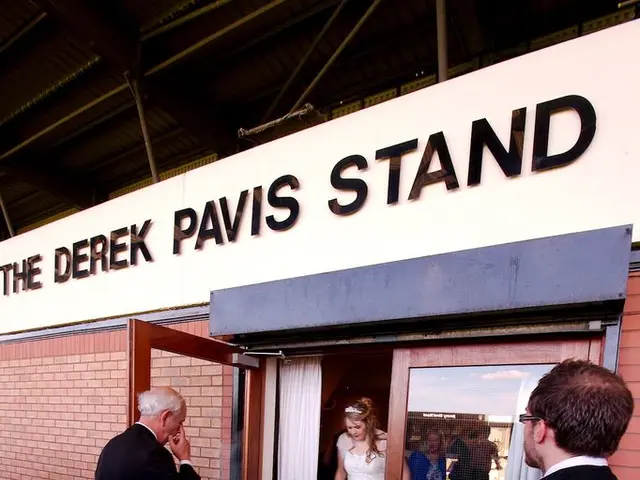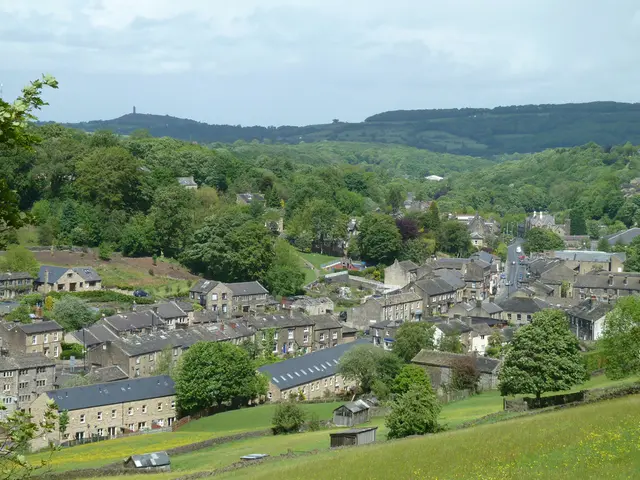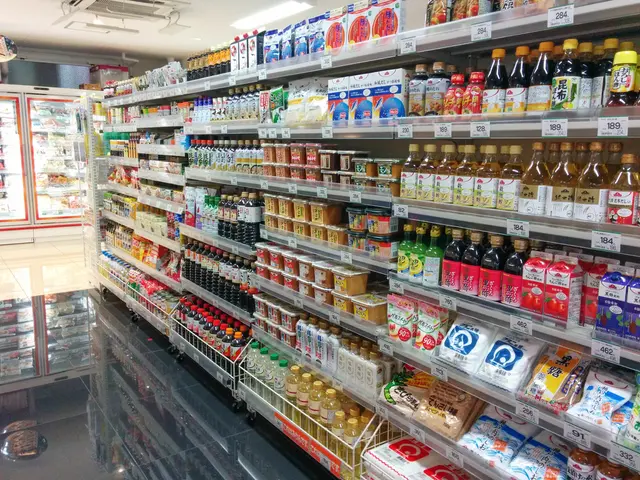Sustainable Constructions Lexicon: Essential Terms and Technologies in Green Architecture
In the realm of eco-friendly building and construction, it's important to be familiar with some common and not-so-common terms and practices. Here's a glossary loaded with various key terms, their explanations, and some fascinating insights:
ABCDEFGHIJKLMNOPQRSTUVWXYZ
A
Acoustic Pollution
An excessive amount of sound that adversely affects both humans and nature. This can include urban noise, construction noise, and loud music. Prolonged exposure can lead to a range of health issues such as stress, sleep disturbances, and hearing loss.
Affordable Housing
This term often interchangeably refers to Housing Affordability. See its entry below.
All-electric Solutions
All-electric solutions encompass using electricity generated from renewable sources for heating, cooling, and powering various appliances in a building. This not only reduces reliance on fossil fuels but also promotes greater energy efficiency.
Anaerobic Digestion Plant
A series of processes that microorganisms carry out in the absence of oxygen, enabling decomposition and eventual production of fuel or biogas. These plants are employed industrially or domestically to manage waste and generate energy.
B
Biocycling
Biocycling involves mixing waste with organisms to create new building materials from old debris. Plants, fungi, and microbes act as "biobinders," forming a type of natural adhesive that holds together pulped construction waste like wood. This eco-friendly process reduces embodied carbon emissions and can even result in a negative carbon footprint.
Biophilic Design
Biophilic design is a concept that embraces nature in our built environment to benefit our well-being. Through incorporating elements of nature such as greenery and natural light, these designs foster human connections to the natural world, promoting mental and physical health.
Bioregionalism
Bioregionalism is a holistic approach to environmental planning, focusing on appreciation and care for the unique characteristics of a particular region. By respecting the ecosystems and cultural heritage of a geographical area, bioregionalism advocates for sustainable living practices and social structures that are harmonious with the local environment.
C
Carbon Capture and Storage (CCS)
Carbon capture and storage is a method to collect CO2 emissions from burning fossil fuels, industrial processes, or producing biomass energy. This carbon is then compressed and stored in deep geological reservoirs or "geological sequestration," minimizing its release into the atmosphere and thereby mitigating the greenhouse effect.
Circular Urbanism
Circular urbanism focuses on sustainable, regenerative, and restorative urban design and development. This concept integrates a holistic approach to urban planning, land use, and infrastructure, aiming to optimize resource efficiency, minimize waste, and create resilient, climate-adaptive cities.
Cities for People
Cities for People is a design philosophy that prioritizes human needs, comfort, and well-being over car-centric urban planning. This concept involves creating walkable and bike-friendly cities with a focus on public spaces, promoting social interactions, and fostering a stronger sense of community.
D
Demolition Embodied Energy (DEE)
DEE refers to the amount of carbon emissions produced during demolition, which encompasses material transportation, storage, and disposal or reuse. Demolishing buildings can contribute significantly to CO2 emissions, and reducing DEE is crucial for sustainable building practices.
Dematerialization
Dematerialization is the process of increasing the efficiency of resource use while simultaneously decreasing the overall consumption of materials. By designing products and services to be more durable, repairable, and recyclable, dematerialization helps conserve natural resources and reduce waste.
E
Efficient Improvements (Energy Star-rated)
Efficient improvements refer to building upgrades that enhance energy efficiency, contributing to reduced energy consumption and utility bills. These improvements often align with Energy Star standards, which recognize products and homes that save energy, money, and help protect the environment.
Embodied Carbon
Embodied carbon refers to the total carbon emissions associated with building and construction materials throughout their life cycle, including extraction, manufacturing, transportation, usage, maintenance, and end-of-life disposal or recycling. Minimizing embodied carbon is essential for creating sustainable buildings.
Energy Efficiency Improvements (EEI)
Energy efficiency improvements encompass measures that make a building use less energy while delivering the same or improved service. Examples include adding insulation, implementing efficient lighting, and upgrading HVAC systems. EEIs contribute to cost savings, increased comfort, and lower carbon emissions.
F
Fair Workplaces and Capable Hands
"Fair Workplaces and Capable Hands" is an initiative focused on creating socially responsible and equitable workplaces within the built environment sector. This program encourages fair labor practices, diversity, and inclusive working conditions, promoting a more just and sustainable industry.
FSC Certified Materials
FSC (Forest Stewardship Council) certification ensures that wooden products come from responsibly managed forests, promoting sustainable forestry practices, preserving biodiversity, and honoring the rights of local communities. FSC-certified materials contribute to reducing deforestation and environmental degradation.
Flexible, Modular Design
Flexible, modular design allows for adaptable, scalable, and customizable spaces within a building. This innovative approach provides solutions for evolving needs, innovative work styles, and improved resource efficiency. Modular systems can also facilitate renovations, expansions, and alternate use of spaces in a building over time.
G
Green Buildings
Green buildings are structures designed and constructed to minimize their impact on the environment, mainly through efficient energy use, water conservation, waste reduction, and durable, non-toxic materials. Green buildings often incorporate various eco-friendly features such as solar panels, rainwater harvesting systems, and energy-efficient appliances.
Green Energy
Green energy refers to energy generated from renewable sources like solar, wind, hydro, and geothermal power. Green energy is environmentally friendly, carbon-neutral, and sustainable, contrasting with energy generated from fossil fuels or nuclear power plants.
Greenwashing
Greenwashing is a deceptive marketing tactic that presents an organization or product as eco-friendly, while not fully embracing sustainable practices. Greenwashing misleads consumers into believing that a particular offering is environmentally friendly when it may not be.
Greywater Recycling
Greywater recycling is the practice of collecting wastewater from showers, sinks, washing machines, and bathtubs for reuse in toilets, washing machines, and irrigation systems. Greywater recycling helps conserve freshwater resources and reduces overall water consumption.
H
Heating, Ventilation, and Air Conditioning (HVAC) Systems
HVAC systems regulate a building's indoor environment, maintaining temperature, humidity, and air quality. Energy-efficient HVAC systems help minimize energy consumption and contribute to reduced carbon emissions, enhanced indoor air quality, and improved occupant comfort.
Heat Pumps
Heat pumps are devices that move heat from one location to another, typically reducing the need for heating and cooling. Using a heat pump can be more energy-efficient than traditional heating methods because it transfers heat rather than producing it directly.
Hydroponics
Hydroponics is a soil-less cultivation method in which plants are grown using mineral nutrient solutions in a water-soluble medium. This method conserves water, reduces waste, and provides a controlled growing environment, allowing for year-round production and better resource management.
I
Indoor Environmental Quality (IEQ)
Indoor environmental quality focuses on the air quality, thermal comfort, visual comfort, and acoustic comfort within a building. Ensuring a high indoor environmental quality is essential for promoting the health and well-being of building occupants, as poor indoor air quality can lead to various health issues.
L
Landfill Methane Recovery (LFG)
Landfill methane recovery captures methane from decomposing organic waste in landfills and converts it into a usable fuel or electricity. By harnessing methane produced during the decomposition of waste, LFG reduces greenhouse gas emissions and contributes to energy production.
Living Building Challenge (LBC)
The Living Building Challenge is a rigorous building certification program that requires projects to meet a series of performance requirements in seven areas: site, water, energy, health & happiness, materials, equity, and beauty. LBC-certified buildings represent exemplary examples of sustainability, representing a new paradigm for built-environment design and construction.
M
Mesh Networks
Mesh networks are decentralized wireless systems that consist of nodes (devices) communicating directly with each other to create a network without a central hub. Mesh networks are resilient, adaptable, and can be used for various applications, including monitoring urban environments, managing IoT devices, and increasing the efficiency of buildings and cities.
Modern Methods of Construction (MMC)
Modern Methods of Construction (MMC) are innovative techniques that use off-site manufacturing to construct buildings faster, more efficiently, and with less waste. MMC can reduce construction time, improve quality control, and minimize environmental impact through the use of pollution-free winters, predictable weather conditions, reduced site traffic, and safer working conditions.
Multifunctional and Adaptable Spaces
Multifunctional and adaptable spaces within buildings facilitate flexibility and accommodates various uses and future adaptations as needs change. These spaces are designed to be easily reconfigurable, allowing for adjustments to the layout, function, and size of rooms, enhancing resource efficiency and maximizing functionality.
N
Natural Ventilation
Natural ventilation safely and effectively circulates fresh air through a building using passive means such as windows, vents, and stacks. Natural ventilation helps reduce energy consumption, improve air quality, and create a healthier, more comfortable indoor environment.
Net-Zero Energy Building (NZEB)
A net-zero energy building is a structure that produces as much energy as it consumes over the course of a year. NZEBs often employ renewable energy sources and energy-efficient technologies to minimize energy consumption, generate on-site power, and achieve carbon neutrality.
Non-Toxic Materials
Non-toxic materials are substances that do not emit harmful chemicals, do not contribute to indoor air pollution, and do not pose a threat to human health or the environment. Using non-toxic materials in buildings is essential for promoting a healthier, more sustainable indoor environment and reducing exposure to harmful toxins.
Off-Grid Energy Solutions
Off-grid energy solutions enable buildings to operate independently of the centralized electrical grid using on-site renewable energy sources like solar panels, wind turbines, or micro-hydroelectric systems. Off-grid energy solutions increase resilience, reduce reliance on fossil fuels, and provide a more sustainable energy source.
P
Passive Design
Passive design is a building design strategy that relies on natural elements like sunlight, wind, and insulation to minimize energy consumption and achieve energy efficiency. Passive design often emphasizes south-facing windows, thermal mass, insulation, and shading to maximize comfort and minimize energy use.
Passive Solar Design
Passive solar design is a building design approach that utilizes the sun's energy to heat and cool a building more efficiently. Passive solar design typically involves the strategic placement of windows, insulation, thermal mass, and shading devices to optimize solar gain and reduce energy consumption.
R
Resource-efficient Reuse and Recycling
Resource-efficient reuse and recycling refers to strategies employed to minimize waste and conserve resources through reusing, repairing, and recycling building components and materials. These strategies reduce the demand for new materials, minimize waste generation, and promote a more circular economy.
Renewable Energy Integration
Renewable energy integration involves using renewable sources like solar panels, wind turbines, or Geothermal systems, to generate electricity for a building. Integrating renewable energy sources into building design can significantly reduce reliance on fossil fuels, minimize carbon emissions, and promote a more sustainable energy future.
Retrofitting Buildings
Retrofitting buildings involves upgrading or modifying existing buildings to increase energy efficiency, improve indoor environmental quality, reduce carbon emissions, and enhance overall sustainability. Retrofitting buildings can also improve the safety, functionality, and market value of buildings.
Reuse and Repurpose
Reuse and repurpose strategies encompass giving new life to building components and materials through refurbishing, reusing, or converting them for alternative purposes. By reusing and repurposing building materials, architects can conserve resources, reduce waste, and create innovative, sustainable design solutions.
S
Sustainable Building Code (SBC)
A sustainable building code is a set of regulations and guidelines designed to promote energy efficiency, resource conservation, and indoor environmental quality in buildings. SBCs aim to minimize carbon emissions, conserve resources, and create healthier, more sustainable buildings.
Sustainable Design Patterns
Sustainable design patterns are reusable, adaptable, and scalable design solutions that address common design challenges in a sustainable manner. Sustainable design patterns encourage efficient use of resources, promote design flexibility, and support long-term sustainability goals.
T
Transitional and Adaptive Spaces
Transitional and adaptive spaces are design solutions that bridge the gap between static, traditional building designs and more flexible, adaptable, and sustainable building designs. These spaces focus on accommodating changing needs and adapting to new circumstances, enhancing their longevity and adaptability while ensuring their sustainability.
U
Urban Agriculture
Urban agriculture refers to the cultivation of plants, animals, and other forms of food production in and around urban areas. Urban agriculture can include gardening on private property, community gardens, rooftop gardens, and hydroponic systems. Urban agriculture promotes food security, improves the urban environment, and supports sustainable living practices.
Urban Heat Island (UHI)
An urban heat island is a phenomenon in which urban areas experience higher temperatures than surrounding rural areas due to human activities, building materials, and architectural designs. Reducing urban heat islands involves increasing vegetation, reflective surfaces, green roofs, and sustainable building practices to create cooler, more comfortable urban environments.
V
Ventilative Cooling
Ventilative cooling uses natural ventilation strategies to cool a building through the movement of air. This technique employs natural ventilation systems that draw in cooler outside air while expelling warmer indoor air, reducing reliance on mechanical cooling systems and promoting a more sustainable cooling strategy.
W
Water Efficient Landscaping (WEL)
Water-efficient landscaping involves designing and implementing outdoor spaces that require minimal water while maintaining an attractive, healthy, and functional landscape. WEL typically incorporates native plants, drought-resistant species, efficient irrigation systems, and permeable surfaces to conserve water and promote a more sustainable urban environment.
Dive into this comprehensive list of terms to familiarize yourself with the wide array of sustainable building and design practices, strategies, and concepts shaping the future of buildings and cities. Embrace a greener, healthier, and more sustainable built environment for a better tomorrow!
- In the context of renewable energy investments in real estate, it's crucial to consider energy efficiency improvements in buildings, particularly those that align with Energy Star standards, as these measures not only reduce energy consumption and utility bills but also contribute to lowered carbon emissions.
- When it comes to financing sustainable housing projects, it is worth noting that there are numerous eco-friendly practices in the industry, such as biocycling, which involves mixing waste with organisms to create new building materials from old debris, thereby reducing embodied carbon emissions and material waste.
- As the demand for green buildings grows, investors should explore opportunities in biophilic design, which emphasizes incorporating elements of nature, like greenery and natural light, into buildings to foster human connections to the natural world, promoting mental and physical health, and ultimately boosting property value in the housing market.








